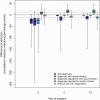How Can Progress Toward Ending the Human Immunodeficiency Virus Epidemic in the United States Be Monitored?
- PMID: 34849635
- PMCID: PMC9403299
- DOI: 10.1093/cid/ciab976
How Can Progress Toward Ending the Human Immunodeficiency Virus Epidemic in the United States Be Monitored?
Abstract
The plan for Ending the HIV (human immunodeficiency virus) Epidemic (EHE) in the United States aims to reduce new infections by 75% by 2025 and by 90% by 2030. For EHE to be successful, it is important to accurately measure changes in numbers of new HIV infections after 5 and 10 years (to determine whether the EHE goals have been achieved) but also over shorter timescales (to monitor progress and intensify prevention efforts if required). In this viewpoint, we aim to demonstrate why the method used to monitor progress toward the EHE goals must be carefully considered. We briefly describe and discuss different methods to estimate numbers of new HIV infections based on longitudinal cohort studies, cross-sectional incidence surveys, and routine surveillance data. We particularly focus on identifying conditions under which unadjusted and adjusted estimates based on routine surveillance data can be used to estimate changes in new HIV infections.
Keywords: HIV; estimates; incidence surveys; infections; surveillance data.
© The Author(s) 2021. Published by Oxford University Press for the Infectious Diseases Society of America. All rights reserved. For permissions, e-mail: journals.permissions@oup.com.
Figures


References
-
- US Department of Health and Human Services. Ending the HIV epidemic. Available at: https://www.hiv.gov/federal-response/ending-the-hiv-epidemic/overview. Accessed 1 December 2021.
-
- Fauci AS, Redfield RR, Sigounas G, Weahkee MD, Giroir BP.. Ending the HIV epidemic: a plan for the United States. JAMA 2019; 321:844–5. - PubMed
-
- Moore M, Boily MC, Mitchell KM, Donnell DD, Cohen MS, Dimitrov DT.. Identifying regions of greatest need for ending the HIV epidemic: a plan for America. J Acquir Immune Defic Syndr 2020; 85:395–8. - PubMed
Publication types
MeSH terms
Grants and funding
LinkOut - more resources
Full Text Sources
Medical

